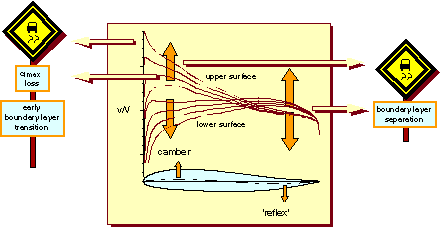To shed more light on the boundary layer problems, we will have a look at velocity distributions of airfoils with reflexed camber lines.

How camber and reflex change the velocity distribution.
The image above presents velocity distributions of four different airfoils with different combinations of reflex and camber. The moment coefficient of all airfoils is similar.
In general, the velocity distributions of the upper surfaces show high velocities in the first third of the chord length, steadily decreasing as the flow reaches the trailing edge. Depending on the Reynolds number, the steepness of the velocity drop (which, according to Bernoulli's equation, represents a pressure rise) is limited. When the pressure rise is too strong, the flow separates, causing loss of lift and increasing drag.
The velocity distribution on the lower surface pose less problems, with a danger for boundary layer separation near the trailing edge. This will have a destabilizing effect and will cause an increase in drag.
A unique feature of airfoils with a reflexed camber line is the crossover of the velocity distributions in the second half of the chord length. Increasing the amount of reflex, speeds up the flow on the lower surface, while it slows down the flow on the upper side. The enclosed area of negative lift near the trailing edge increases, driving the moment coefficient towards positive (more stable) values.
Increasing the camber will increase the velocity on the upper surface and decrease the speed on the lower surface. The enclosed area of positive lift in the front half of the airfoil also increases, contributing to the lift. When the camber is increased too much, the maximum lift may decrease, because the camber has to be compensated by a larger amount of reflex, putting more stress on the boundary layer. Typically, the maximum lift can be increased to a certain amount, by increasing camber and reflex, but at the cost of a harder stall, which might be dangerous during takeoff and landing.
Last modification of this page: 21.05.18
![]()
[Back to Home Page] Suggestions? Corrections? Remarks? e-mail: Martin Hepperle.
Due to the increasing amount of SPAM mail, I have to change this e-Mail address regularly. You will always find the latest version in the footer of all my pages.
It might take some time until you receive an answer
and in some cases you may even receive no answer at all. I apologize for this, but
my spare time is limited. If you have not lost patience, you might want to send
me a copy of your e-mail after a month or so.
This is a privately owned, non-profit page of purely educational purpose.
Any statements may be incorrect and unsuitable for practical usage. I cannot take
any responsibility for actions you perform based on data, assumptions, calculations
etc. taken from this web page.
© 1996-2018 Martin Hepperle
You may use the data given in this document for your personal use. If you use this
document for a publication, you have to cite the source. A publication of a recompilation
of the given material is not allowed, if the resulting product is sold for more
than the production costs.
This document may accidentally refer to trade names and trademarks, which are owned by national or international companies, but which are unknown by me. Their rights are fully recognized and these companies are kindly asked to inform me if they do not wish their names to be used at all or to be used in a different way.
This document is part of a frame set and can be found by navigating from the entry point at the Web site http://www.MH-AeroTools.de/.